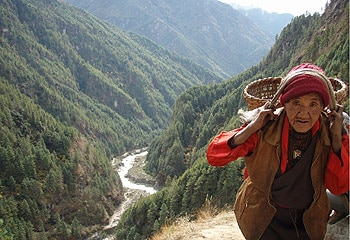Call of Nepal's sky goddess
SEEING the world's tallest mountain wasn't the only high point of Brad Crouch's memorable trek in Nepal, where stunning views blend with rich tradition.

At almost 4000m above sea level, Tengboche isn't quite the roof of the world ... but you can see it from there.
The Nepalese village, centred on a Buddhist monastery high in the Himalayas, has stunning views of some of the highest mountains on Earth, including the big one: Mount Everest.
Breathless from the altitude (or maybe it was the adrenalin), I sucked in deep gasps while looking at the highest place on Earth - in a T-shirt.
To the Nepalese, Mt Everest is Sagarmatha, or Mother Goddess of the Sky. It looms with such majesty that human affairs pale into insignificance.
We had spent the best part of a week trekking to reach this point. And though the highest mountain on the planet (8848m) was a thrill, this trip was more about the journey than any particular destination.
The idea of trekking in Nepal had come loaded with questions. Would I be fit enough? Would we have to climb mountains? How cold would it be?
What about altitude sickness, bad weather, food, washing, the call of nature?
It turned out to be surprisingly simple. World Expeditions took care of the details so we could enjoy the incredible views, culture and company.
Our group of 10 was met at Kathmandu Airport, then had an evening briefing before flying next day to the village of Lukla - by Yeti Airways, no less.
The group ranged from 11-year old schoolboy Tom to 61-year-old grandfather Jim, ramming home the point that you don't have to be an elite athlete to tackle a trek.
World Expeditions grades its treks according to the challenge, and this one was rated introductory.
If you can cope with a decent hike through hilly terrain and enjoy camping, you could easily do this.
In fact, the first day's walk of just three hours, from Lukla to Phakding, proved so enticing that most of us wanted to press on for more.
There are no roads in this part of the world, just walking tracks. No cars, no mobile phones, no TVs or blaring stereos. Just some of the most dramatic views on the planet.
Nepal has about 30 ethnic groups and as many languages, but this region is mainly peopled by the Sherpa and is strongly Buddhist.
From Lukla, the track winds through hills following the route of Dudh Kosi, a thundering glacial river. The path ranges from alley-wide to a goat track, but every turn reveals an extraordinary new view.
Our route took us from Lukla to Phakding, Monjo and the Sherpa capital of Namche Bazaar to Tengboche and back.
As we pressed on, the climbs became steeper, the gorges deeper and the views more spectacular. Mountains such as Kusum Kanguru (6369m), Nupla (5885m), Kongde Ri (6093m) and Thamserku (6808m) dominated the skyline, cloaked in snow.
Mornings dawned crisp and clear to showcase incredible landscapes, although clouds rolled in after lunch each day to shroud the higher peaks.
During the day it was generally T-shirt weather, but we learned to rug up quickly when we reached camp, as temperatures can drop to -5C overnight.
Our group soon got to know one another: we shared two-man tents, ate communal meals in a mess tent by lamplight, swapped stories, shared jokes and learned the joys of the toilet tent.
Every morning we were woken at 6am with a cup of tea and a bowl of hot water for a wash, had a quick brekkie and were on the track.
Our porters left early each day with our gear to set up the next campsite. As they set out purposefully, we strolled with our Sherpa guides, who encouraged us to take it easy, drink in the views and acclimatise to the rising altitude. It was a trek, not a race.
Our path took us through the wilderness of the Sagarmatha National Park, but also from village to village, where tea houses sell everything from Mars Bars to mo-mos (delicious, meat-filled steamed buns).
Buddhist temples, monasteries, prayer wheels and other touches added a mystical element to the walk.
Mantras were carved into stones, known as mani walls. The mantra "om mani padme hum'' (hail to the jewel in the lotus) is hypnotically seductive. Ommmm ...
We walked through pine forests thick with ferns and mosses, to rhododendron forests, past cascading waterfalls and across impossibly high suspension bridges with barely room for two to pass.
On one swaying bridge, I had to stop midway, where a wooden plank had broken underfoot, while a yak squeezed past.
As we walked, we got to know our Sherpa guides, incredibly strong yet gentle men with an impish sense of humour.
The trek grew progressively harder as the days went on, broken by a day in Namche Bazaar to acclimatise to less oxygen at higher altitudes.
It was at Namche that we got our first glimpses of Mt Everest, from a lookout with a good interpretive centre.
This was a highlight, but in many ways it was just one more glorious mountain on a trip where every corner was a Kodak moment.
Also around us were Ama Dablam (6856m), Nuptse (7896m) and Lhotse (8511m), awe-inspiring and humbling.
Better views of Everest came at the remote village of Tengboche, where we unfurled a row of Buddhist prayer flags and gave our thanks for being alive.
All too soon, it was time for the last day of trekking: a solid eight-hour hike, with plenty of steep sections, back to Lukla and the promise of a hot shower.
We celebrated with a beer that night and reflected on the journey of a lifetime.
In 10 days, I had lost five kilos and gained an insight into mystical Nepal. I returned lightened and enlightened.
The writer was a guest of World Expeditions and Thai Airways International.
The Sunday Telegraph



